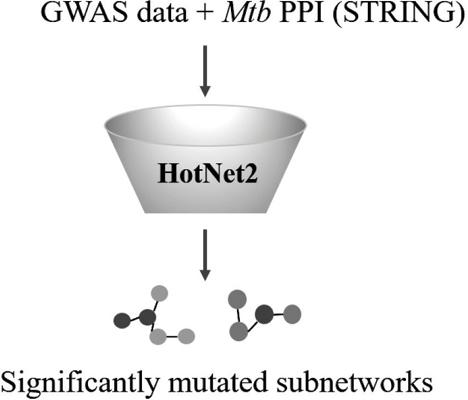Protein & Peptide Letters ( IF 1.6 ) Pub Date : 2020-07-31 , DOI: 10.2174/0929866527666200313113157 Ze-Jia Cui 1 , Wei-Tong Zhang 1 , Qiang Zhu 1 , Qing-Ye Zhang 1 , Hong-Yu Zhang 1

|
Background: Tuberculosis (TB), caused by Mycobacterium tuberculosis (Mtb), is one of the oldest known and most dangerous diseases. Although the spread of TB was controlled in the early 20th century using antibiotics and vaccines, TB has again become a threat because of increased drug resistance. There is still a lack of effective treatment regimens for a person who is already infected with multidrug-resistant Mtb (MDR-Mtb) or extensively drug-resistant Mtb (XDRMtb). In the past decades, many research groups have explored the drug resistance profiles of Mtb based on sequence data by GWAS, which identified some mutations that were significantly linked with drug resistance, and attempted to explain the resistance mechanisms. However, they mainly focused on several significant mutations in drug targets (e.g. rpoB, katG). Some genes which are potentially associated with drug resistance may be overlooked by the GWAS analysis.
Objective: In this article, our motivation is to detect potential drug resistance genes of Mtb using a heat diffusion model.
Methods: All sequencing data, which contained 127 samples of Mtb, i.e. 34 ethambutol-, 65 isoniazid-, 53 rifampicin- and 45 streptomycin-resistant strains. The raw sequence data were preprocessed using Trimmomatic software and aligned to the Mtb H37Rv reference genome using Bowtie2. From the resulting alignments, SAMtools and VarScan were used to filter sequences and call SNPs. The GWAS was performed by the PLINK package to obtain the significant SNPs, which were mapped to genes. The P-values of genes calculated by GWAS were transferred into a heat vector. The heat vector and the Mtb protein-protein interactions (PPI) derived from the STRING database were inputted into the heat diffusion model to obtain significant subnetworks by HotNet2. Finally, the most significant (P < 0.05) subnetworks associated with different phenotypes were obtained. To verify the change of binding energy between the drug and target before and after mutation, the method of molecular dynamics simulation was performed using the AMBER software.
Results: We identified significant subnetworks in rifampicin-resistant samples. Excitingly, we found rpoB and rpoC, which are drug targets of rifampicin. From the protein structure of rpoB, the mutation location was extremely close to the drug binding site, with a distance of only 3.97 Å. Molecular dynamics simulation revealed that the binding energy of rpoB and rifampicin decreased after D435V mutation. To a large extent, this mutation can influence the affinity of drug-target binding. In addition, topA and pyrG were reported to be linked with drug resistance, and might be new TB drug targets. Other genes that have not yet been reported are worth further study.
Conclusion: Using a heat diffusion model in combination with GWAS results and protein-protein interactions, the significantly mutated subnetworks in rifampicin-resistant samples were found. The subnetwork not only contained the known targets of rifampicin (rpoB, rpoC), but also included topA and pyrG, which are potentially associated with drug resistance. Together, these results offer deeper insights into drug resistance of Mtb, and provides potential drug targets for finding new antituberculosis drugs.
中文翻译:

使用热扩散模型检测结核分枝杆菌的潜在耐药基因。
背景:结核分枝杆菌(Mtb)引起的结核病(TB)是已知最古老,最危险的疾病之一。尽管在20世纪初使用抗生素和疫苗控制了结核病的传播,但由于耐药性的提高,结核病再次成为一种威胁。对于已经感染了多重耐药性Mtb(MDR-Mtb)或广泛耐药性Mtb(XDRMtb)的人,仍然缺乏有效的治疗方案。在过去的几十年中,许多研究小组根据GWAS的序列数据探索了Mtb的耐药性谱,发现了一些与耐药性显着相关的突变,并试图解释耐药性机制。然而,他们主要集中在药物靶标上的几个显着突变(例如rpoB,katG)。
目的:在本文中,我们的动机是使用热扩散模型检测潜在的Mtb耐药基因。
方法:所有测序数据,包括127份Mtb样品,即34株乙胺丁醇,65株异烟肼,53株利福平和45株链霉素耐药菌株。使用Trimmomatic软件对原始序列数据进行预处理,并使用Bowtie2将其与Mtb H37Rv参考基因组进行比对。从得到的比对中,使用SAMtools和VarScan过滤序列并调用SNP。通过PLINK软件包执行GWAS,以获得重要的SNP,并将其定位到基因。通过GWAS计算的基因的P值被转移到热载体中。将来自STRING数据库的热载体和Mtb蛋白质-蛋白质相互作用(PPI)输入到热扩散模型中,从而通过HotNet2获得重要的子网。最后,获得了与不同表型相关的最显着(P <0.05)的子网。
结果:我们在耐利福平的样品中鉴定出重要的亚网络。令人兴奋的是,我们发现了rpoB和rpoC,它们是利福平的药物靶标。从rpoB的蛋白质结构来看,突变位置非常接近药物结合位点,距离仅为3.97Å。分子动力学模拟表明,D435V突变后rpoB与利福平的结合能降低。在很大程度上,这种突变会影响药物-靶标结合的亲和力。另外,据报道topA和pyrG与耐药性有关,可能是新的TB药物靶标。其他尚未报道的基因值得进一步研究。
结论:将热扩散模型与GWAS结果和蛋白质-蛋白质相互作用结合使用,发现耐利福平样品中的显着突变的亚网络。子网不仅包含已知的利福平靶标(rpoB,rpoC),而且还包含有可能与耐药性相关的topA和pyrG。在一起,这些结果为Mtb的耐药性提供了更深刻的见解,并为寻找新的抗结核药物提供了潜在的药物靶标。



























 京公网安备 11010802027423号
京公网安备 11010802027423号